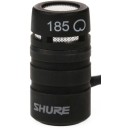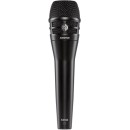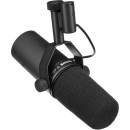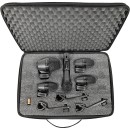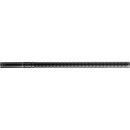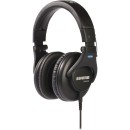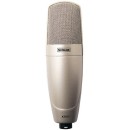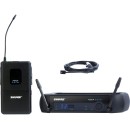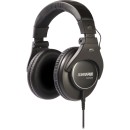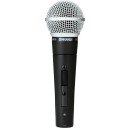Shure SRH1840 Review
Open-Back Over-Ear Headphones
Introduction
In this article, we delve into a detailed analysis of 6,725 user reviews from various languages worldwide to examine the Shure SRH1840. This analysis is performed by the RR artificial intelligence and updated daily with newly submitted reviews. The RR AI utilizes a complex algorithm to first scrutinize user reviews for credibility, filtering out unreliable ones. It then proceeds to dissect and evaluate the valuable insights within these reviews, providing users with ratings regarding the features of this product. Based on these assessments, users can make informed decisions about whether this product is suitable for them or not.
Ratings Based on Features
These results are a summary of user reviews of the Shure SRH1840. For example, 89% of 1,076 users who have commented on the Sound quality of the Shure SRH1840 have given positive feedback.
Highlighted Customer Reviews
Showing 1 to 8 of 8 Reviews
Shure SRH-1840 Stereo Headphone Review

Shure SRH1840 Open-Back Over-Ear Headphones (New Packaging)
Reviewed by Dale on B&H Photo Video
The first thing people want to know about a new headphone is How does it sound? In the case of the SRH-1840 the verdict is: Excellent. The second question people ask is Is it worth the cost? That determination is purely subjective of course, and takes into account things other than the sound. My verdict: Yes, with no reservations. I'll get to the details of that sound after first describing the 1840's physical characteristics.The SRH-1840 has a proprietary double-entry detachable cable that's about seven feet long and straight (not coiled), terminated by a standard straight (not angled) miniplug. A 1/4 inch (6.35mm) adapter is supplied and screws onto the miniplug. I can't be certain whether the miniplug would fit into any of the recessed sockets on music players that have such things, but the threaded portion of the plug ahead of the business end is 7mm in diameter including the threads. The cord is made up of two side-by-side strands that are bonded together, where each strand is 3mm thick, and those two strands separate at a strain-relief and join the earcups 'Y'-style.Many people feel that single-entry headphone cables are a better choice because they're more convenient, i.e. they don't get tangled as much as double-entry cables. The price for that convenience is potentially worse sound due partly to the fact that the total cable length going to each driver is different, and partly to the requirement for a thin cable running across the headband to get the signal to the second earcup. Fortunately, the SRH-1840 matches my personal preference.The SRH-1840 comes with two identical cables, the 6.5mm adapter, an extra set of velour earpads, and a semi-hard carrycase that affords good protection when transporting the headphone.Since the 1840's cable has a standard miniplug with optional 6.5mm adapter, one might assume that Shure intended that it could be used with portable music players. Since laptop and desktop computers also have miniplug jacks, and because the 1840 is less efficient than most of the headphones that are typically used with portable music players, I'm going to assume that the intent for the miniplug is to be used primarily with computers. I did try a few relatively low-volume tracks with the iPod Touch alone, and while those were barely adequate for playback indoors where it's fairly quiet, they would not be adequate for playback on-the-go. If you do require that kind of playback with the 1840, you will probably need to increase the volume of at least some of your music tracks.The earpads are fully circumaural and plush velour, with openings that measure approximately 1-5/8 by 2-1/2 inches. The inside of the cups have cloth-covered thin spongy pads so the ears don't contact anything that would cause discomfort. The earcups appear to be some type of high-grade plastic, with a headband of metal alloy that provides good flexibility, light clamping force, and (since the 1840 is so light), good stability with no tendency to shift when I move my head around.The headband has small spongy pads underneath which feel very comfortable on my head, but if there is any tendency for discomfort in spite of the very light weight of the headphone, I recommend pulling the earcups down just slightly more than the minimum, to let most of the weight be borne by the earcups and not the headband. Note that the earcups of the SRH-1840 do not rotate in any direction, although there is a small amount of movement back and forth to allow alignment of the earcups to different sized heads.The SRH-1840 is a snazzy-looking headphone if you've seen photos of it, so it has a modest bling factor that you don't have to pay a premium for. I would rate its appearance as 8.5 out of 10 and I would rate its comfort factor equally high. The reason the appearance doesn't get a 9 or better is because the 1840 isn't a fashion headphone, so my subjective rating of 8.5 is probably as good as you can get for a serious hi-fi product like this. The reason I didn't rate the comfort 9 or higher is because the 1840 is a full-size headphone with moderate clamping pressure to keep it stable on your head. Having said that, I've never had a full-size headphone that felt this comfortable - the next best thing to no headphone at all.I'd like to describe the sound of the 1840 in terms of a predecessor - the Shure SRH-940 - partly because they are family-related, partly because I have both, and partly because it will be a less complex task given certain similarities.The SRH-1840's general signature is best described as: Bass and upper treble very similar to the 940, with the midrange tilted more toward the lower end than the 940's. This makes the 1840 slightly darker and warmer than the 940, although that warmth as I use the term does not contribute to any sensation of extra bass. In fact, the 1840 (as is the case with the 940) is bass-neutral, and those users who prefer more bass than what the 940 provides will have the same impression of the 1840 - not for bass-heads. The 1840's midrange is essentially flawless with great rendition of voices and instruments, and given the overall smoothness from the top of the treble to the bottom of the bass, as perfect a listening experience as I've had.Being an open-back design, the SRH-1840 has almost no isolation. The soundstage is slightly better than the 940's, which might surprise some users who aren't aware of the 940's above-average soundstage for a closed-back design. Listening to the 1840 I never get a sense of constriction, compression or any other such quality - the sound is always airy and effortless. Sibilants seem less bothersome with the 1840 than most other premium headphones I've used, and there is one very important aspect of the 1840's sound that merits special mention: The quality of the upper harmonics of instruments and voices is exactly what I would hope for in a premium headphone but don't always get.For this review I mostly used a Dell desktop with premium soundcard playing FLAC format tracks in Foobar2000. Some of those tracks, notably certain recordings by David Chesky, sound so amazingly good with the SRH-1840 that I'm often startled by their realism and clarity. Some tracks that I use I don't have FLAC copies of, and those MP3's (320k CBR) sound nearly as good on the iPod Touch connected via the line out dock to an Objective2 assembled headphone amp as they do on the desktop computer. A more ideal configuration would be a good DAC running from the desktop or laptop USB, feeding into a decent headphone amp like the Objective2 or better, but given the spectacular sound I'm getting already I have no doubts about the ultimate quality of the SRH-1840 headphone.Now that I've covered the basics of the sound, it's time to describe how the SRH-1840 sounds with a variety of music that's available on CD's or as high-quality downloads from Internet music stores. I've used the following examples in other reviews, so these will serve as good test tracks for this review and the results can also be compared to the results noted in the other reviews.10000 Maniacs - Peace Train (late 80's); pleasant sound, great details and good soundstage depth.Andrea True Connection - More More More (late 70's): Classic disco, very smooth, big soundstage.Bauhaus - Bela Lugosi's Dead (1980): Strong midrange sound effects - this is a good worst-case test for resonant-type sounds in the most sensitive midrange area. Handled very well by the SRH-1840.Beatles - And I Love Her, Things We Said Today, I'll Be Back, I'll Follow The Sun (1964, in stereo): Amazing sound quality and decent soundstage, with excellent voice and instrument detail. These four tracks are a perfect example of how good high fidelity recordings could be as far back as the 1960's.Beethoven Symphony 9, Solti/CSO (1972): Excellent overall sound and particularly striking how the SRH-1840 reproduces the triangles, bells and other background instruments that are often obscured with other headphones that have limited high frequency response. Of special note for this headphone are the bass impacts beginning around 10:30 of the fourth movement.Bill Evans Trio - Nardis (early 60's): Fairly close-up recording, and despite soft highs, excellent instrumental detail, particularly the upright bass and piano.Billy Eckstine - Imagination (date??): Sounds like a recent high-quality stereo recording. Excellent from top to bottom, wide soundstage and overall a great vocal demo.Blood Sweat & Tears - And When I Die, God Bless The Child, Spinning Wheel (late 60's): Excellent sound quality, and fortunately (I think) given the strength of the brass instruments, the highs are slightly soft.Blues Project - Caress Me Baby (1966): Rarely mentioned, but one of the greatest white blues recordings ever. The loud piercing guitar sound at 0:41 into the track is a good test for distortion or other problems. Handled very well here.Boz Scaggs - Lowdown (1976): Good sound quality - this is a great test for any nasality in the midrange. Handled very well by the SRH-1840.Buffalo Springfield - Kind Woman (1968): A Richie Furay song entirely, rarely mentioned, but one of the best sounding rock ballads ever. This will sound good on most headphones, but it's a special treat with the SRH-1840.Cat Stevens - Morning Has Broken (early 70's): A near-perfect test for overall sound - this track will separate the best sounding headphones from the lesser quality types. Nothing specific, except that almost any deviation from perfect reproduction will stand out with this track.Catherine Wheel - Black Metallic (1991): Goth with industrial overtones - I like this since it's a great music composition and the sound effects are smoothly integrated into the mix. This may sound distorted or mushy with some headphones, but the SRH-1840 renders the deliberate instrumental distortions clearly.Cocteau Twins - Carolyn's Fingers (1988): Unusual ambient pop with excellent guitar details.Commodores - Night Shift (1985): Good spacious sound with very detailed bass guitar lines.Cranes - Adoration (1991): Excellent piano sound leading into a goth-flavored song with very unusual vocals.Creedence Clearwater Revival - The Midnight Special (1969??): Classic CCR featured in Twilight Zone, this track has great guitar sounds and a really good ambience despite a mediocre soundstage.Dave Brubeck Quartet - Take Five (1959): Paul Desmond piece - good test of saxophone sound and cymbals, less so most of the other instruments.Dead Can Dance - Ariadne (1993??): Atmospheric goth music - good ambience in spite of mediocre soundstage.Def Leppard - Bringin' On The Heartbreak (1981): MTV goth/pop/metal at its best - good ambience and high energy - the better headphones will separate the details and make for a good experience. Lesser quality and the details tend to mush together.Del Reeves - Girl On The Billboard (early-mid 70's): Classic truck-drivin' country tune with a Thelma & Louise theme, this song's overall recorded quality (almost typical of Nashville in the 70's) is a superb demo if you can get past the peculiar lyrics.Dick Hyman - Dooji Wooji (1990??): Swing-era composition played with perfect technique by all band members, with excellent recorded sound.Frank Sinatra - Theme From New York, New York (1980): Ultimate Sinatra with big band production and well-balanced sound.J.S. Bach - E. Power Biggs Plays Bach in the Thomaskirche (1970): Recorded on a tracker organ in East Germany, the tracks on this recording have the authentic baroque sound that Bach composed for, albeit the bellows are operated by motor today. The SRH-1840 plays the tones seamlessly through the upper limits of the organ, which are near the upper limits of my hearing.Jamming With Edward - It Hurts Me Too (1969): Intended originally as a test to fill studio down time and set recording levels etc., this was released a few years later for hardcore Rolling Stones fans. Although not as good technically in every aspect as the Chess studio recordings of 1964, and in spite of the non-serious vocals by Mick Jagger, this rates very high on my list of white blues recordings, and sounds absolutely delicious with the SRH-1840.Jim Ruiz Group - Katerine (1998?): Unusually spacious and ambient indie-pop recording with a samba flavor. Every pop song should sound this good, in my opinion.Jimmy Smith - Basin Street Blues (early 60's): This track has some loud crescendos of brass and other instruments that don't sound clean and musical on some headphones. The SRH-1840 provides excellent reproduction. Listen particularly to the second crescendo at 15 seconds in, for maximum detail effect.Kim Carnes - Bette Davis Eyes (Acoustic version, 2006?): Stripped-down (acoustic) version of the big hit - good voice and excellent guitar sounds.Ladytron - Destroy Everything You Touch (2009): Featured in The September Issue, this song has heavy overdub and will sound a bit muddy on some headphones.Merle Haggard - Okie From Muskogee (1969): Another good-quality country recording with almost-acoustic guitar accompaniment. Lovely guitar sounds.Milt Jackson/Wes Montgomery - Delilah (Take 3) (1962): The vibraphone is heavily dependent on harmonics to sound right, and the SRH-1840 plays it superbly.Nylons - The Lion Sleeps Tonight (A Capella version, 1980's): High-energy vocals sans instrumental accompaniment - an excellent test of vocal reproduction.Pink Floyd/Dark Side of the Moon - Speak To Me (1973): Strong deep bass impacts will be heard and felt here.Rolling Stones - Stray Cat Blues (1968): Dirty, gritty blues that very few white artists could match. On some headphones the vocals and guitar lack the edge and fall more-or-less flat. If you're a really good person, playing this song will probably make you feel nervous and uneasy.Tony Bennett - I Left My Heart In San Francisco (1962): Frank Sinatra's favorite singer. Highest recommendation. With some of the best headphones, the sibilants on this recording are very strong, but they're not bad with the SRH-1840. ... More
The best in its price range

Shure SRH1840 Premium Open-back Headphones
Reviewed by ClintD on Guitar Center
Hard to beat In its price range, these are the best of the $600 and below. Great clarity and awesome soundstage. The sound is neutral. Highs, Mids and Lows are balanced, the bass is there, it just doesn't slam with impact, as mixing headphones should not anyway. The separation and detail of instruments are phenominal. They even have the edge over Beyerdynamic DT 1990 Pro, the 1990 only beats it in bass impact. Hifiman Sundara slightly beats it in separation of instruments. My overall pick is the 1840, the comfortable level is great, light as a feather to almost any headphone, no clamping here. If price is an issue, Hifiman Sundara is the best way to go. Of course any of the headphones and 1840 cannot compete with my newly purchased Hedd Heddphone. Overall I am satisfied. ... More
Even better after months of use

Shure SRH1840 Open-Back Over-Ear Headphones (New Packaging)
Reviewed by Len on B&H Photo Video
After several months of use these phones are continually pleasing. Easy to wear but sturdy. A sometimes startling open and multi-dimensional soundstage. I'm not a golden ear but mine hear honest, accurate, well-balanced, satisfying reproduction. No sound in the middle of your head phenomenon.
Not for me

Shure SRH1840 Open-Back Over-Ear Headphones (New Packaging)
Reviewed by Keith on B&H Photo Video
I hate writing a negative review, because I am a fan of Shure products and these really are impressive. I thought I should write to perhaps help someone avoid the same mistake. Let me be clear, it might not be a mistake for you. I bought these for mixing purposes as they are advertised as being neutral, which is true, and very detailed, which is true, and comfortable, which is beyond true---the quality and feel are both superb. They are also wonderful at revealing flaws--if you mix or master on these, Im sure the results would be very good, as you would have ironed out all of the rough spots. So where is the problem? They hurt my hearing--literally. Im not exactly sure why, but after wearing them for any length of time, at even low volumes, I want to rip them off of my head. There is just too much energy in the sound. Like a reverberant airy field on top of everything---the best I can describe it. What is ironic, is that at first listen I was impressed by how smooth the highs sounded. Its not the actual highs that cause the problem, but a field of high-frequency sonic energy. Every time I tried them, even for a few minutes, I had tinnitus for several hours afterwards! After becoming familiar with it, the quality of the sound was no longer pleasant to me either, but rather fuzzy--too much air. I would call the sound revealing, but not cohesive. I also noticed that some rich instruments are too much for them and the sound breaks up. The stereo image is also too wide for my taste. So--I would call them a useful tool--if you can use them! ... More
SRH 1840 Headphones

Shure SRH1840 Open-Back Over-Ear Headphones (New Packaging)
Reviewed by Kenneth A on B&H Photo Video
The SRH 1840 are use for critical listening to mix and mastering audio material. They are very neutral with a well define low end. At this time they are not fully burned in, but the translation between phones to speakers is great. Audiophiles will love them for their good retain price.
Ads




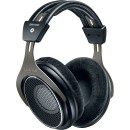






For engineers that know how to supplement using 'cans'.

Shure SRH1840 Premium Open-Back Headphones
Reviewed by Luis T. on Reverb
GREAT product. Especially for those engineers that know their monitors, warts and all, and understand how to use headphones as a supplementary tool along with your normal monitoring set up. Flat, no hype, accurate monitoring.
Excellent Headphones for Studio

Shure SRH1840 Professional Open-Back Headphones (Previous Version)
Reviewed by Daniel F on Guitar Center
Great headphones for mixing and master music and longer period use
Highly recommend for mixing music in a pro and home studio.

Shure SRH1840 Premium Open-back Headphones
Reviewed by Val on Guitar Center
High definition sound for pros and who live a great sound
